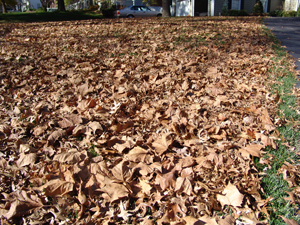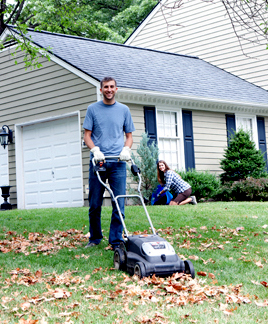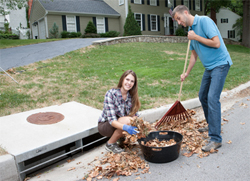Healthy Yard and Environment Tip: October
Leaves. Leaves. Leaves. 
Leaf removal and yard waste management
Proper removal of the leaves is an important part of a fall lawn care program, especially if new grass was planted.
Fallen leaves are not toxic to the grass and have little, if any, nutrient value. But leaves are an excellent source of organic matter for the soil once composted or broken down naturally. Our local heavy clay soils benefit greatly by the addition of organic matter, but the amount created by a small layer of chopped leaves is not nearly enough to make any difference.
Leaves left on the lawn can kill the grass
The problem with leaves is that they create shade. Excessive shade from a layer of leaves reduces the amount of sunlight the grass receives. This shading occurs during the time when the cool season grasses, tall fescue and bluegrass, are experiencing optimal growth conditions. The reduction in growth at this time can have long-term effects on the vigor of the lawn.
Leaves do not need to be removed immediately. One of the first signs of excess leaf cover is the yellowing of the turf from lack of sunlight. A thick layer of leaves should be removed about every four days for best growth. Newly seeded or young grass plants should have the leaf pile removed as quickly as possible to increase establishment.
Proper leaf disposal
Disposal of leaves can involve:
- raking,
- bagging,
- composting or
- mulch mowing the leaves back into the turf.

Developing strategies for using the leaves in the landscape is the best option. This may be difficult for many, given the amount of leaves. Most opt for catching the leaves with the lawn mower bag. Bagging on the first pass results in a lot of bulk, as the leaves are light and fluffy. The bulk can be reduced by double mowing. Double mowing means first mowing without using the bagging attachment to chop the leaves. Then a second pass is made catching the leaves. The volume of leaves can be reduced by up to 75 percent. This does take more time but is effective.
Not all leaves must be removed. Mulching the leaves back into the lawn does not harm the grass. Studies have shown that with a good mulching mower as much as three to four inches of leaves can be chopped and left on the turf. The fine leaf particles quickly work into the turf to naturally compost. They do not contribute to thatch. Once the chopped leaves begin to pile up on the turf they must be removed.

